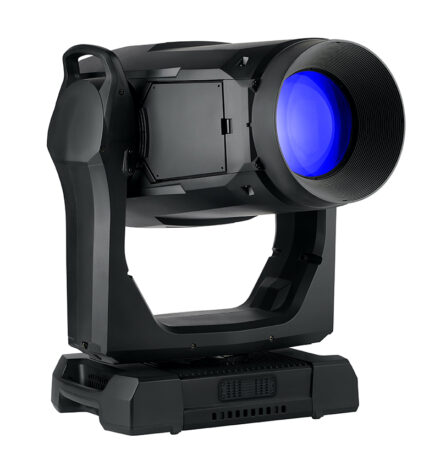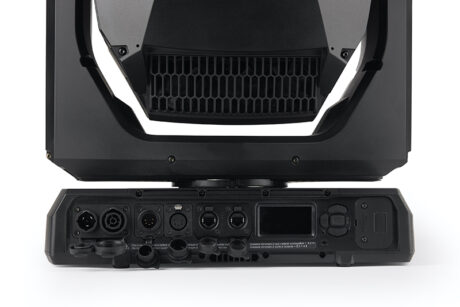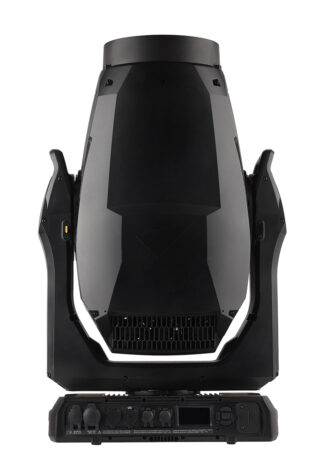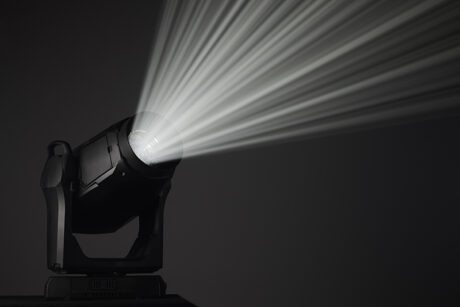
Martin Professional’s MAC Viper was (and remains) an impressive piece of engineering. Released in 2012, this 1,000W moving light quickly set the standard by which all other automated hard-edged lights were judged. On top of being housed in a reasonably sized package, especially by the standards of the time, the Viper touted a new color mixing system that promised true mixed reds, as well as an updated gobo set that left behind the more intricate patterns of the MAC 2000 Profile and introduced some wonderfully chunky aerial effects gobos. While still viable, the advantages and clear industry trend has been toward LED fixtures and their attendant advantages, and so a non-arc lamp version of this light was more or less inevitable. The Martin MAC Viper XIP is the newest iteration of the light, and the version we’ll be looking at in this Road Test.

LED Light Engine
The Viper XIP bears a passing resemblance to its older brother, with similar exterior styling including the lifting handles at the top of the yoke for easy lifting. The source is a Martin-designed custom LED module being under-driven at 760W to improve the longevity of the LEDs. As an aside, it’s amazing to me how far we’ve come in terms of the sheer raw power of white LEDs in the past 10 years. The very idea of having enough LED power to create a viable hard-edge light was difficult to imagine back then, and while I still look forward to the day when RGB (+) becomes viable in this role, it’s still an impressive technological achievement. The Viper XIP’s LED array is rated by Martin at 5,800K; I measured a slightly higher reading at 5,900K at the output. Un-altered, the TM-30 values are Rf: 66 ±3, and Rg: 94: ±3, with a minus green filter that Martin calls the “Spectral Enhancement Filter” on the fixed color wheel to improve the rendering to Rf: 80 and Rg: 107. Because I saw this unit at a public demo, I was not able to measure any thermal effects of the unit warming up. As it was, I measured 14,610 lux from five meters at 50% zoom, and the fixture had been running for many hours before I took my reading. While the LED module is replaceable, Martin—through under-driving the LED array—believes the lifetime of the LEDs will be such that replacements should be rare. The array is driven at a PWM frequency of 2,400 Hz, which should be high enough to avoid any camera artifacts, though this refresh rate can be adjusted for odd situations.
Dimming
I have full faith in the engineers at Martin to build a spectacular dimming system into their fixtures, and the Viper XIP did not disappoint. Dimming throughout the range was very good, with performance at the low end of the range being particularly excellent. Dimmer curve measurements used to be an important part of my reviews, now with LEDs in general and manufacturers like Martin and other industry leaders specifically, getting nearly mathematically perfect curves is expected. (It’s also, I expect, technically less challenging in some ways than designing a perfect mechanical dimmer.) There are four curves to choose from; the fixture defaults to a square-law curve, which can be changed via the menu or over DMX.
Color & Effects
Effects ride on two removable modules, the effects module and the color mixing module. On the color module we find the common “glass curtains” configuration of CMY/CTO filters. Color mixing was generally even and smooth across the beam, with really pleasing dark blues in particular. One other color bears mentioning here, and that’s red, which was—as expected—somewhat orange. This is notable as the marketing for the original MAC Viper leaned into that system’s true mixed red, and one of the enduring disadvantages of white LEDs as they are currently realized is a lack of red energy in the output spectrum. This is simply an inevitability of all fixtures using white LEDs, certainly not unique to the Viper XIP, but I did notice it. Speed-wise, the Viper XIP’s color mixing system delivers, with absurdly fast color changes that will do colors bumps and near-snaps well. A fixed color wheel with five colors plus open complements the mixed colors, the aforementioned Spectral Enhancement Filter, CTB, a deep amber, Congo blue, and of course, a primary red, all with the familiar wedge shape that allows for pleasing split colors and effects. A separate CTO flag smoothly adjusts the color temperature down to ~2,850K.

Gobos & Animation
Twin rotating gobo wheels live on the effects module, each with seven rotating and indexing gobos plus open. I liked the gobo selection; they seem mostly geared toward aerial effects, though there are a few that would work very well projected onto scenery. Gobo rotation was very smooth down to the slowest speeds, and this fixture has the trick of color-correcting for an inserted gobo, something we’ve seen on other Martin lights. The fixture omits a fixed gobo wheel.
An animation wheel also rides on this module, fully rotating and indexable, with a variable insertion angle to create various snow, water, fire, and other ‘organic’ lighting effects. Also on this module is a variable iris to reduce the beam diameter, as well as the framing shutter assembly. The framing shutters lie on two planes perpendicular to the output, as opposed to the slightly more common four. This keeps the blades more in focus, while some collision-detection software is there to help prevent you from smashing a blade into another. The blades are very fast, and the entire module rotates ±83°, and each blade is full curtain, and can completely cover the beam.
Frost/Prism/Zoom Range
Further up the optical train lay a pair of frost flags. The medium flag fuzzes the edges of gobos somewhat, leaving shapes still somewhat visible, and as with many flags of this type, acts as a contrast reducer until fully inserted. A heavier frost creates a wash effect with pronounced falloff at the edges. These frosts are usable throughout the zoom range, which is a nice touch. A four-facet circular prism provides good image separation and is also fully indexable and rotatable. Zoom range is an impressive 5.7° to 51° and is also quite fast. I appreciated that the fixture focuses on gobos very nearly (though not all the way) to the narrowest portion of its zoom range, something I’ve seen other spot fixtures struggle with.
Exterior Use
Being an outdoor-rated light, the Viper XIP comes with an IP54 rating instead of the more commonly seen IP65 rating. For those unfamiliar, the ‘5’ in the code indicates that while the unit is not dust sealed, it is dust-protected, and dust will not cause the fixture any problems, while the ‘4’ indicates that the unit can withstand splashing water from any direction. I suspect this is unlikely to have major implications with regard to outdoor shows, though for installations in more challenging environments (fountain displays or extreme weather conditions) the use case scenario will be important to consider.
Control via DMX and RDM is through 5-pin XLR, or etherCON inputs and pass-throughs for direct Art-Net, sACN, and Martin’s P3 protocol, and an optional wireless DMX module is available. Of further interest is the upcoming Martin app, which allows a user to communicate with the light via NFC (Near-Field Communication) to set options and addresses via a phone, just like using a mobile phone payment at a retail store.
The MAC Viper XIP weighs 81.1 lbs. and stands 29.8” high, with a base 16.9” x 11.1”. Power in is via Neutrik powerCON TRUE1 inputs and pass-throughs, and the fixture auto-ranges power from 100-240V AC.

Coming Soon to a Venue Near You
The Martin MAC Viper XIP is an excellent continuation of the Viper line and represents the state of the art of LED-based automated lighting. I suspect we’ll soon see them on large tours, festivals, and events of every kind where efficient and high-output lighting is needed.
Martin Professional MAC Viper XIP
PROS
- Bright output
- Very good dimming curve, especially excellent at the low end
- Great zoom range
- Really pleasing dark blues
- Absurdly fast color changes
CONS
- No wash version planned
SPECS
- Light Source: 760W Proprietary LED Light Engine w/ 55 x 20W White LEDs
- Output: 28,000 Lumens
- CCT: 5,800K (± 250 K)
- Front Lens: 150 mm
- Zoom Range: 1:9; 5.7° – 51°; Focus with Auto Tracking
- Movement: Pan: 540°, Tilt: 268°
- Input Range: AC power, 100-240VAC Nominal, 50/60 Hz
- Power Draw (Max): 1,040W
- Dimming: 0 – 100% Continuous Dimming and Strobe Effects
- Dimming Curves: 4
- Color Mixing: CMY, Color Wheel with 5 Dichroic Filters, including Spectral Enhancement Filter
- Color Temperature Control: 5,800K – 2,850K
- Virtual CTC Control: 2,000K – 12,850K
- Green Magenta Shift Control
- Rotating Gobo Wheels: 2, each with 7 Interchangeable Gobos + Open
- Gobo Animation Wheel: Indexing, Continuous Rotation with Variable Angle
- Framing Module: Individual +/- 30° Across Entire Beam and ± 83° Rotation
- Iris: Yes
- Frost: 2 (fade in), Light & Heavy
- Prism: 4-Facet
- Pre-Programmed Effects: Two Ranges of Pre-Programmed FX
- Control: DMX-512 In/Out; etherCON In/Out for P3, Art-Net, sACN; Built in Ethernet switch with Fail-Safe Bypass
- P3 Video Mapping of Fixture Color and/or Intensity (6 segments)
- Cooling: Low Noise Cooling System
- Noise Levels: User-Selectable Output vs. Sound Level Control
- Connectors: (2) Neutrik powerCON TRUE1 TOP Power Input, Neutrik 5-pin locking XLR TOP (DMX/RDM), Neutrik etherCON TOP (Ethernet)
- IP Rating: IP54
- Dimensions: Height (max): 30.6” x Width (Yoke) 18.9” x Length (Head) 23.4”; Max. Center-to-Center Distance: 27.7” + Clearance
- Weight: 81.1 lbs.
MANUFACTURER: Martin Professional
More Info: www.martin.com/en-US/products/mac-viper-xip


